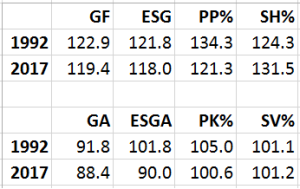First, a huge thanks to Pensblog’s Stephen S., for creating the awesome “Back to Back 2016-2017” graphic. Remember to check out his Penguins championship art now available on stickers and shirts. Stephen is the Crosby and Malkin of design. Unbelievable talent and skill.
A quarter century later, some things don’t change: A Republican with flagging popularity is in the White House and the Pittsburgh Penguins are Stanley Cup champions for a second straight year. Soon after the final horn sounded at Bridgestone Arena in Nashville on Sunday night, the comparison of the 1992 and 2017 Penguins, both of whom successfully defended their championships, began.
This team, fully healthy, vs. 91-92 Pens, seven game series. Who wins?
— Chris Mueller (@ChrisMuellerPGH) June 12, 2017
This is certainly one of the great honors and privileges of being a Penguins fan. As you bask in the glow of another Stanley Cup win, you can debate inside your mind or with older family and friends on whether this Penguins Cup-winning team was better than other Penguins Cup-winning teams, unlike Capitals fans who can only debate over which of the nine eliminations by the Penguins hurt them the most.
Since 25 years separate the two back to back championship teams, the fairest way to compare the 1992 and 2017 clubs is to assess each team’s statistics relative to their respective season’s league averages to see how far ahead (or behind) their competition each squad finished in relevant categories.

For goals allowed (GA) and even strength goals allowed (ESGA), the difference between 100 and any number below 100 represents percent better than league average. For example, the 2017 Penguins 90.0 ESGA means they allowed 10% fewer even strength goals than league average during the 2017 playoffs. Conversely, the 1992 Penguins allowed 1.8% more even strength goals relative to league average.
Unsurprisingly, the 1992 and 2017 Penguins were very similar in terms of overall goal scoring and at even strength, beating the league average by around 20%, with a small advantage to the 1992 club. Both teams featured the #1, #2, #3 and #4 playoff point scorers. In 1992, it was Mario Lemieux (16! goals and 34 points in 15 games), Kevin Stevens, Ron Francis and Jaromir Jagr topping the chart while this season it was Evgeni Malkin, Sidney Crosby, Phil Kessel and Jake Guentzel.
On the power play, while this season’s Penguins struggled against Washington and Nashville, they still finished 21% higher than league average. However, the 1992 team simply overwhelmed their opponents, finishing a ridiculous 34% higher than league average. Perhaps this is not surprising considering the future Hall of Famers that would skate onto the ice whenever the 1992 Penguins began a man advantage situation. Lemieux, Jagr, Francis, Larry Murphy (and should-have-been Hall of Famer) Stevens.
No power play opportunity represents the talent of the 1992 team better than the final seconds of Game 1 of the Stanley Cup Final at Civic Arena, tied 4-4. Lemieux had drawn a penalty when he forced Blackhawk Steve Smith to haul him down near the Chicago blue line. The Pens had battled back from 3-0 and 4-1 deficits to draw even.
[youtube https://www.youtube.com/watch?v=BZxOdNFtvRs]Years ago, when I asked former Penguins Radio Network host Bob Grove in an email what his most memorable Mario moment in Civic Arena was, this was his reply:
“His goal to win Game 1 of the 1992 Cup Final against Chicago was the ultimate demonstration of his uncanny ability to do something great at precisely the most pivotal moment. When the spotlight was on him, when the pressure was turned up, Mario came through.”
I figure if Grove, the man who wrote the official history of the Penguins first 30 years, said this was the ultimate Mario moment, then that’s good enough for me.
One underrated aspect of both the 1992 and 2017 Penguins clubs was how they cut down on goals allowed and improved their penalty kill when the playoffs started. During the regular season, both teams were below average in both categories but when the postseason started, they shored up their PK. During the past two months, Matt Cullen seemed to win faceoff after faceoff in the most important defensive situations while Brian Dumoulin and the durable shot-blocking machine, Ian Cole, logged heavy PK minutes. In 1992, it was Jim Paek and Ulf Samuelsson and Bob Errey and veteran Bryan Trottier often carrying the load shorthanded. And when Lemieux was deployed, well … it was just unfair:
[youtube https://www.youtube.com/watch?v=j8ufe1zxn6E]As for goaltending, one surprising discovery was that the 1992 and 2017 Penguins netminders finished with essentially identical save percentages above league average. The oft-criticized Tom Barrasso – 6-1 in one-goal 1992 playoff games – was a rock in net when the Pens closed out the second round series over the New York Rangers, the Presidents’ Trophy winners. Similarly, Marc-Andre Fleury bent, but did not break when the 2017 Pens eliminated Washington, the Presidents’ Trophy winners with a Game 7 shutout on the road. Rookie Matt Murray was better than both of them, turning in a playoff performance for the record books. He topped all goalies in save percentage and shutouts despite not seeing any playoff action until the middle of the third round.
Matt Murray: 4th goalie to close out Stanley Cup Final with shutouts in consecutive games – first since Terry Sawchuk in 1952 (@EliasSports)
— ESPN Stats & Info (@ESPNStatsInfo) June 12, 2017
Clearly, there are so many similarities between the 1992 and 2017 Stanley Cup champion Penguins but two common themes are “resilience” and “adaptation”. The 1992 Penguins lost elite goal scorer Joe Mullen in Game 2 of the second round against the Rangers to a season-ending knee injury, an injury overshadowed by the infamous Adam Graves slash on Lemieux’s wrist that shelved #66 for 5 ½ games. It was at this point that Jagr, just 19, stepped up and became a superstar. In Lemieux’s absence, Jagr blitzed the Rangers for 3 goals and 3 assists including a memorable penalty shot goal that stunned Madison Square Garden. A few weeks later, Jagr tied the game that Lemieux won on the previously mentioned clutch PP goal, by adding the Deke to End All Dekes against Chicago.
[youtube https://www.youtube.com/watch?v=jT3P8aTLkW4] [youtube https://www.youtube.com/watch?v=Jwoh4HGmfdQ]This season, the Penguins lost all-around defenseman Kris Letang for the entire playoffs due to a neck injury. Up stepped Justin Schultz, taking Letang’s spot on the power play, leading the blue line in scoring with his accurate shot from center point that either found the back of the net or set up rebounds for second chances. When Patric Hornqvist and Bryan Rust were injured, Carter Rowney and Scott Wilson stepped up to ease the burden of minutes on an already overtaxed team.
And what about the masterminds behind the bench? Scotty Bowman’s winning but stoic reputation precedes him but he changed his hard-headed style to adapt and relate to the relaxed 1992 Penguins team. With the Penguins down 3-1 to Washington in the first round, Bowman and Lemieux decided to counter the Caps’ style of play with a “1-4 delay” defensive system. The Pens turned the tables and came back to win the series.
Naturally, Mike Sullivan sought advice from the master Bowman, and adapted effectively to every challenge this season as well. He handled what could have been a large goaltender controversy by using Fleury to perfection in the first two rounds, then reinstated Murray as the starter – no matter what – for the final 1 ½ rounds. Five of the Pens’ 16 playoff wins were shutouts. Sullivan weathered the Pens’ appalling injury storm for the past five months without panic. He juggled lines without hesitation, finding great success by pairing rookie Guentzel with Crosby and getting the Cup-winning goals from Hornqvist and Carl Hagelin Sunday night, though both had been moved down the depth chart.
[youtube https://www.youtube.com/watch?v=EIijEnz3T4A#t=0m39s]If someone put a gun to my head and said “Best-of-seven, ’92 Pens vs. 2017 Pens. Who wins?” I would have to go with the 1992 club. Based on what actually happened, not just a stat sheet, one cannot ignore how the 1992 Penguins closed the playoffs on a rampage – a record 11-game playoff win streak, defeating opponents in a variety of comebacks, blowouts and one-goal games.
That we can even have this debate is a testament to the excellence of the Penguins organization – five Stanley Cups and now, a pair of back-to-backers.
Add The Sports Daily to your Google News Feed!
